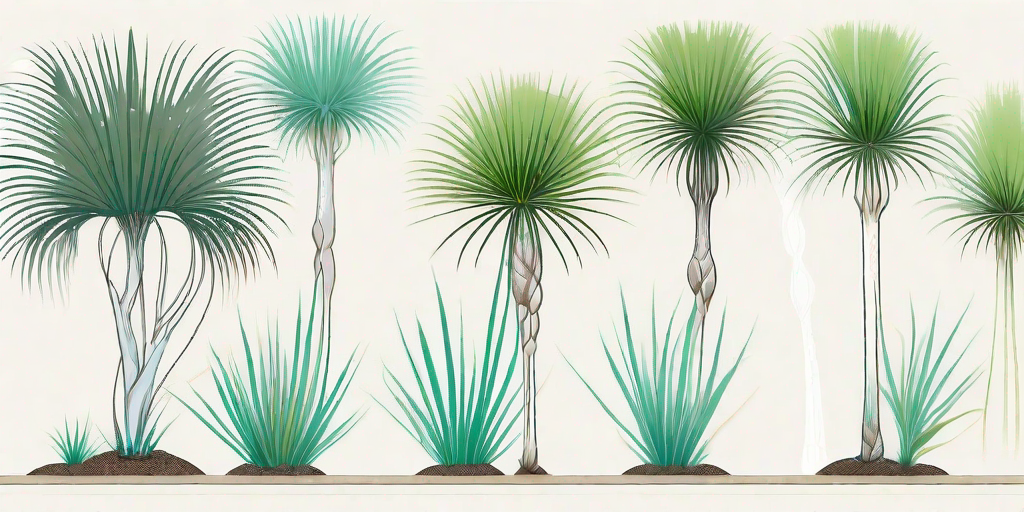
If you've ever gazed upon a Ponytail Palm and thought, "I wish I had an army of these," then you're in the right place. We're not talking about a literal army, of course, but a posse of these charming, low-maintenance plants can certainly add a touch of greenery and whimsy to your home or garden. So, let's dive into the world of propagating Ponytail Palm pups and get you started on your journey to becoming a Ponytail Palm parent.
Understanding the Ponytail Palm
Before we get our hands dirty, it's essential to understand what a Ponytail Palm is. Despite its name, the Ponytail Palm, also known as Beaucarnea recurvata, is not a palm but a succulent. This cheeky plant, native to eastern Mexico, is known for its bulbous base, slender trunk, and a crown of long, cascading leaves that resemble a ponytail, hence the name.
One of the most intriguing aspects of the Ponytail Palm is its ability to produce 'pups' or 'offsets.' These are essentially baby plants that grow from the base of the parent plant. And it's these pups that we'll be focusing on in our propagation guide.
Propagating Ponytail Palm Pups: The Step-by-Step Guide
Now that we've covered the basics, it's time to roll up your sleeves and get to the fun part - propagation. But fear not, even if you don't have a green thumb, the process is relatively straightforward and, dare we say, enjoyable.
Step 1: Identify the Pups
The first step in propagating your Ponytail Palm is identifying the pups. These are the small, bulbous growths that appear around the base of the parent plant. They look like mini versions of the parent plant, and if you're lucky, you might find several pups growing at once.
However, don't be too hasty to remove the pups. They need to be mature enough to survive on their own. A good rule of thumb is to wait until they are about 4 inches tall before considering propagation.
Step 2: Remove the Pups
Once the pups are mature enough, it's time for the separation. Using a sharp, clean knife, carefully cut the pup away from the parent plant. Make sure to include some roots if possible, as this will help the pup establish itself in its new home.
After removing the pup, let it dry out for a few days. This allows the cut area to callous over, reducing the risk of infection or rot when you plant it.
Step 3: Plant the Pups
After the pup has dried out, it's time to plant it. Choose a pot with good drainage and fill it with a well-draining soil mix, ideally one designed for succulents. Place the pup in the soil, ensuring the base is well-covered, and water it lightly.
Then, it's a waiting game. The pup may take a few weeks to establish itself and start growing, so be patient. With proper care, you'll soon have a new Ponytail Palm to add to your posse.
Common Mistakes to Avoid
While propagating Ponytail Palm pups is relatively straightforward, there are a few common mistakes to avoid. These include overwatering, planting the pup too deep, and being too impatient.
Remember, Ponytail Palms are succulents, and they don't like to be overwatered. Wait until the soil is completely dry before watering again. Also, ensure the pup is planted at the right depth - not too deep, not too shallow. And finally, be patient. Propagation takes time, and your pup may take a while to show signs of growth.
Frequently Asked Questions
- How often should I water my Ponytail Palm pup?
As a rule of thumb, water your Ponytail Palm pup once the soil has completely dried out. This could be once a week or once every two weeks, depending on the climate and the pot's size.
- Can I propagate a Ponytail Palm from a leaf?
Unfortunately, no. Ponytail Palms can't be propagated from leaves like some other succulents. They propagate through pups or offsets that grow at the base of the parent plant.
- Why isn't my Ponytail Palm producing pups?
There could be several reasons for this. The plant might not be mature enough, or it might not be getting the right care. Ensure your Ponytail Palm is getting enough light, and you're not overwatering it.
Conclusion
And there you have it, a comprehensive guide to propagating your own Ponytail Palm pups. With a bit of patience and care, you'll soon have a posse of these charming plants to call your own. So, go forth and propagate!
Remember, every plant parent journey is unique, and there's no such thing as too many Ponytail Palms. So, whether you're a seasoned green thumb or a budding plant enthusiast, we hope this guide has inspired you to try your hand at propagating Ponytail Palm pups. Happy planting!















